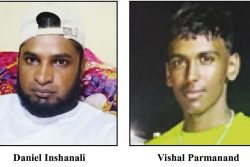Hive of Activity
All eyes have been plastered on the behavior of gold over the last few years as the price of the commodity created enormous buzz and stirred many to invest in the industry in Guyana. The hive of activity has seen the movement of goods and people in unprecedented frequency and in unprecedented numbers between Georgetown and the gilded poles of Region 7 and 8. Those operating in the industry raked in a staggering G$109 billion last year alone, 47 percent more than was expected from the budget projections of 2012. Within the last four years the revenue generated by the industry has grown by leaps and bounds reaching an aggregate of G$268 billion. Undoubtedly, those numbers have caused some industries to go on the offensive and may have caused others to beat a quiet retreat.
Very Narrow

The Lucas Stock Index (LSI) increased marginally by 0.97 percent in light trading during the fourth week of April 2013. A mere 9,600 stocks of five companies changed hands. Demerara Bank Limited (DBL) traded the highest number of stocks, 3,300, with a 3.82 percent increase in value. Demerara Distillers Limited (DDL) traded 2,100 shares and saw the value of its stock increase by 9.02 percent. Republic Bank Limited (RBL) traded 3,000 shares with no change in value. Both Guyana Bank for Trade and Industry (BTI) and Demerara Tobacco Company (DTC) saw no change in value with trades of 400 and 800 units of their stock respectively.
One sector of the economy that might owe its expansion to the good fortunes of the gold industry is transportation and storage. Like with other economic situations, measuring the true impact of the gold industry on the transport and warehousing activities is difficult. Part of the reason is that road transport statistics do not measure purpose of travel like air transport does. The principal activities in the interior locations are mining and logging which suggest that the transport to the interior are linked to those purposes. Travel by minibus or taxi is not segregated which is another reason it is difficult to say how much traffic is directed to the interior for the purpose of serving the mining industry. Nonetheless, according to the 2013 Budget statement, the transportation and storage sector grew at an astronomical 19 percent, suggesting that there might have been some impact of the industry on the transport sector. Despite the growth in transportation and storage, the returns to investors in the industry are relatively small. In fact, the industry recorded the smallest income to output ratio, suggesting that the room for significant profits is very narrow.
Tax Levels
The distributive trade also saw significant growth albeit less than the transport and storage industry. At seven percent, the increase in spending was good for government revenues, even if not entirely phenomenal for personal income. The sector earned the second highest gross returns with $1.63 for every unit of output. There has been a sizable growth in imports of all types of goods, with capital goods leading the way with an increase in excess of 16 percent. The growth of imports was not only in capital goods. The importation of consumption goods went up by about 12 percent while non-fuel intermediate goods expanded by 13 percent. The income garnered was good for both the financial services sector and the government. Financial services recorded growth of nearly 14 percent suggesting that there might be plenty money around. The spending was good for government revenues too. Trade and consumption taxes continued to dominate tax levels, contributing about 60 percent of government tax revenues as they have been doing in the years following the revision of the tax structure.
Baron of the Economy
Growth rates in other parts of the economy might be attributable more to the level of government spending than to the fortune of the gold industry. Be that as it may, the gilt of gold shines brighter than the crystals of our sugar. Once the baron of the economy, sugar might now be the bane of the country. The GUYSUCO story is a special one and has been critically written upon extensively by Professor Clive Thomas.. But, one cannot help noticing how straight-faced the administration is about the failures of sugar. The promise of something different from the industry each year never seems to materialize, but it gets money anyway. It is treated like a revolving fund where every year we seem to return 14 percent of its export revenues in the form of subsidies, something that does not happen in any other industry.
As sweet as the sugarcane might be, it does not have the appeal that it once had, and might be retreating from more than the weather and inefficient management. The downward march of the industry did not start in the era of gold. Sugar has been showing the signs of fatigue for a long time as observed by Professor Thomas in an article appearing in the Stabroek News on November 18, 2012. Not only has it been incurring losses, but it has been flaunting its inefficiency by spending more to produce less.
A read of the last four budget statements on the matter sounds like a refrain of frustration and hopelessness. The excuses for the poor performance of the industry are not changing. They go like this “inclement weather, industrial relations disruptions and management inefficiency”, “inclement weather and industrial relations disruptions”. With those sounds coming out of the industry, one cannot be sure if the theme of the budget “Overcoming Challenges Together and Accelerating Gains for Guyana” applies to GUYSUCO.
Era of Prolific Growth
The construction industry seems to be in retreat too from a place of prominence as well. The industry shed about 13 percent of its output last year in a year of prolific growth. The administration accepts responsibility for the decline of the output of the industry. The mere two percent increase in income accruing to the industry is nothing close to its heavenly days of 2008 when income grew by eight percent. Since that time the industry has been showing signs of struggling to keep its gross income up. One would have to keep an eye on the construction industry to see if, despite all the attention that it is getting, it would continue to produce marginal gains like manufacturing.
Fate
Decisions on the 2013 budget proposals have already been made, and more are yet to come. Despite the situation with GUYSUCO, the money proposed for that company has been approved. It remains to be seen if GUYSUCO will disappoint the financiers of the National Assembly. As sugar remains sweet tasting, the fate of the construction industry might be tied to the fate of the housing and public works budget. It remains in danger of growing slowly, if at all, with increased spending on public infrastructural works.








